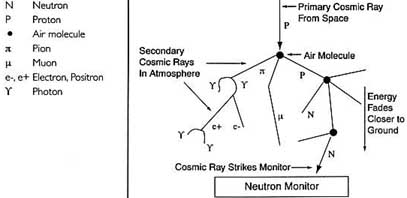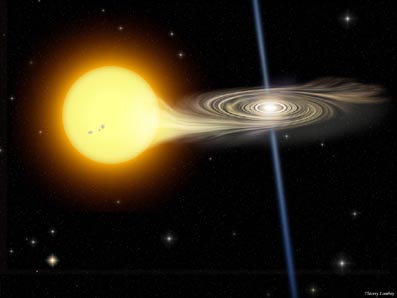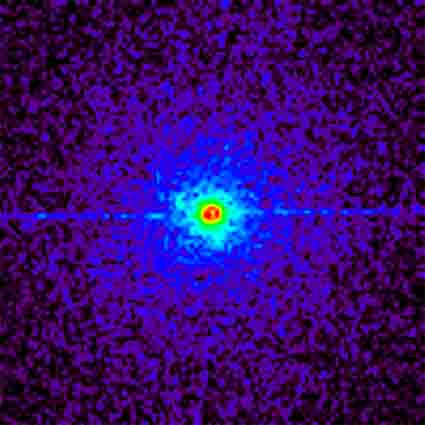![]()
![]()
xx. Children of the Swan

In the 1980s deep underground particle
decay detectors in Europe and the United States, as well as ground-based
air shower detectors, registered anomalous incoming cosmic rays unlike
any others registered before. They bore a 'fingerprint' periodicity
of 4.8 hours, previously recorded in connection with X-rays and infrared
radiation coming from a binary star system named Cygnus X-3, located
some 30,000 lights years away on the other side of our galaxy. Known
to astrophysicists as a high mass X-ray binary, it consists of a tiny
compact object, either a neutron star or black hole, that accretes,
that is steals, mass from its huge companion, known as a Wolf-Rayet
star. Visually speaking, Cygnus X-3 is located at the very centre of
Cygnus's cross design, next to the star Sadr, even though dust and gas
in the galactic plane obscure its presence in the optical range of frequencies.
The exact nature of the cosmic rays from Cygnus X-3 are extraordinary. They are tens of thousands of times stronger than anything produced by particle accelerators, and since they are neutral (in that they have no charge) and arrive directly from Cygnus (as opposed to their route being distorted by the galactic gravitational field), it indicates that they travel here very close to the speed of light.
 |
In addition to the qualities outlined so far, the strange particles from Cygnus X-3 are uniquely able to penetrate hundreds of metres of solid rock before finally crashing into atomic nuclei to form secondary particles, detected by deep underground facilities around the world. No other point source cosmic ray, besides neutrinos - which are caused by nuclear fusion reactions in the sun and supernovae and pass through matter with almost no interaction - are known to do this. This has led to speculation that cygnets are produced by exotic strange quark matter inside Cygnus X-3's suspected neutron star. Despite claims from many particle physicists that this data has to be erroneous, Cygnus X-3's cosmic rays keep coming, being last reported again in 2000. |
Could it be possible that these same particles from Cygnus X-3 were being experienced deep underground as far back as Palaeolithic times, and did they in some way affect the ancient mindset to look towards Cygnus as the source of cosmic life and death? The announcement in 2000 that Cygnus X-3 is quite possibly the first confirmed microblazar in the galaxy, with a one-side particle jet, or beam, pointing towards the Earth, has thrown considerable light on the nature of cygnets, and the importance of this binary star system. Galactic blazars produce jets with relativistic, i.e. light speed, acceleration, easily creating the means for cygnets to reach the earth in the manner that they do.
|
Neutron star/black hole drawing gas from its companion star. Note the production of relativistic jets. |
Relativistic jets have been noted in connection with other stellar bodies in the galaxy, usually either black holes or neutron stars, but none of these have are aimed at the Earth, which is what singles Cygnus X-3 out as a microblazar as it has been termed so as not to confuse it with galactic blazar, associated with supermassive black holes at the centre of AGNs (Active Galactic Nuclei), millions if not billion of light years away from Earth. Marking Cygnus X-3 out as even more unique is that only its cosmic rays are known to penetrate deep underground, something that might easily have been occurring since Palaeolithic times, simply because astrophysicists know that Cygnus X-3 has been in its current phase of evolution for up to 700,000 years. Did our most ancient ancestors somehow become subtly aware of the existence of Cygnus X-3, most obviously during psychedelic experiences in deep cave settings? Did they come to associate its proximity, i.e. the stars of Cygnus - Sadr and Deneb in particular - with cosmic creation and the transmigration of the soul? |
|
Cosmic radiation might easily have contributed to changes in human behaviour, or even sudden accelerations in human evolution, especially during the Palaeolithic age, when cave art, cosmology, astronomy, intellect and possibly even transatlantic travel emerged for the first time. However, this would have been a subtle process that took place over countless generations, and away from the harsher influence of indiscriminate cosmic rays bombarding the planet's surface from a host of different point sources. More likely is that low level radiation, like that experienced by health seekers in radon mines today, was actually beneficial to the human body and mind, especially hundreds of metres underground where we know cosmic rays from Cygnus X-3 are able to penetrate. Ice cores from Summit, Greenland, and Vostok, Antarctica, at the other end of the earth, show that levels of Beryllium-10, a radioactive substance created as a by product of cosmic ray interaction in the upper atmosphere, were more than double towards the end of the Last Ice Age, with massive peaks of activity around firstly c.40,000-37,000 BP and then again c.17,000-14,000 years ago. Was at least a percentage of these cosmic rays derived from Cygnus X-3? Did Cygnus X-3 help accelerate human evolution, c. 17,000-15,000 years ago, and arguably even earlier? |
Cygnus X-3 taken by the Chandra X-ray Observatory in 2001. picture credit: NASA/CXC/SAO. |
![]()

